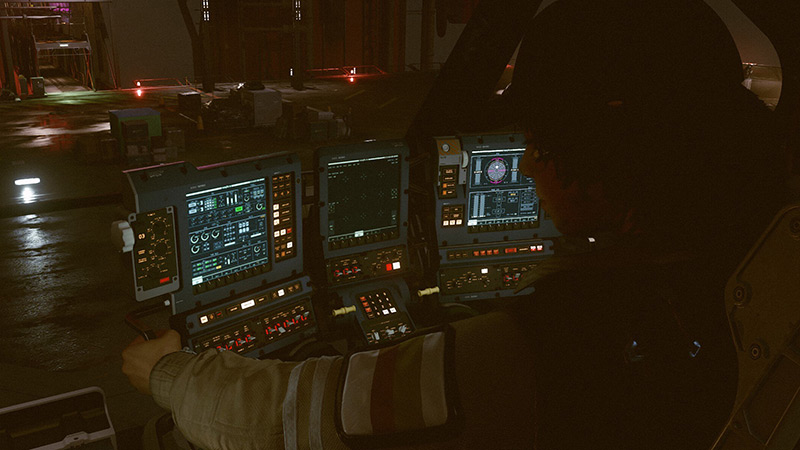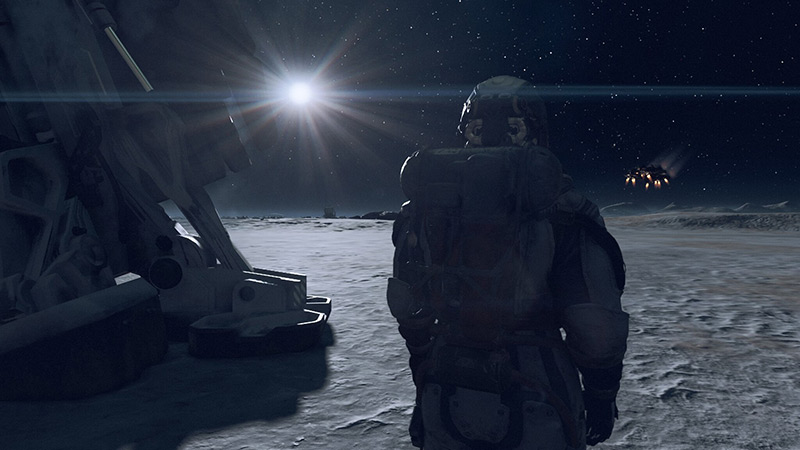Starfield
Starfield (notes ⇣) is a first and third person open world shooting game with cut and dialogue scenes set in a fiddly 300-years-in-the-future Apollo program-inspired space inhabited by bickering humans and alien fauna with red health bars over their heads.
Shoot until those bars are empty, then navigate a list to put the items they carried in your own bulging pockets, a constraining inventory space with a user interface (UI) with ALL UPPERCASE NAMES for items, that make finding things difficult.
HyperTextHero Starfield videos originally streamed live on Twitch:
I’m picky about usability and typography, and feel the choice of NB Architekt, an ALL-CAPS typeface for inventory item names is the easiest thing to fix that is to blame for the Starfield UI’s interruption of the game’s flow, making the player spend too much time looking for things in their own pocket instead of doing things in the game world.
There are other typefaces in the UI that have lowercase letters, such as the one used for item descriptions, so I hope they become the default in a future patch.
Starfield does have modding support, and I may even go in and see if I can improve the inventory typography and add better visual indicators for which inventory I’m currently in, my avatar’s, or my ship’s, while I’m at it, for goodness’ sake, though this may have already been done.
Maybe the ability to pick everything up and the subsequent inventory space and weight problems is a commentary on the excesses of human society? No need to carry 3 dumb bells, 9 trays, and 15 fire extinguishers along with your 7 helmets and 11 weapons.
Levelling up to unlock abilities takes time, and makes me pause, perhaps for too long, to think about which career or gameplay direction my character should go.
Around 27 years ago I played a Bethesda Softworks game called Daggerfall and loved it. It felt infinite, with a storyline and quests set in a procedurally-generated world.

Procedural generation with hand-crafted elements is a holy cup of my favorite drink to quaff while gaming, and weaving together hand-crafted world and story design with computer-generated data is tricky, so when a big group of people like Bethesda workers attempt walking in together while holding a giant tray without crashing, it is an event to be celebrated, despite broken vessels.
I can build my own space craft with a chunky ship design aesthetic, and even outposts, both of which would be more fun if I could invite friends over, if the game were multiplayer. At his point we’re stuck with non-player characters and companions.
Dialogue options can be funny and a few quests made me second-guess myself about tricky decisions, but most, like UC Sys-Def, felt rather dull.
In Starfield I travel between star systems and planets with one click from a somewhat confusing star map, then around areas a few square kilometers in size to find points of interest (POIs) like derelict bases and caves.
The POIs eventually repeat themselves, and after several “abandoned listening outposts” with the same exact layout and enemies on many different planets, the immersive spell of being in the world is broken.
This was a disappointing, but suspect it will always be a difficult thing to balance when making games of this types and this size.
Keith Burgun, on randomness in game design, specifically, the section on Complexity Effectiveness:
If your game is a continuous series of events that lead deterministically from one to the other, then you are maximizing the amount of unique situations that can occur. I think this idea is counter-intuitive to many, who think that random events occurring somewhere in there must increase the amount of unique situations. However, the opposite is actually the case.
Emily Short, writing about computer-generated content in games (emphasis mine):
But to speak for myself: I think the key question in oatmeal-avoidance is whether the generation is connected to anything mechanical. I might be able to generate haiku, or funny food names, or imaginary constellations, or names of funny English-sounding towns, but all that generation is purely decorative unless it is tightly correlated with gameplay — and the player will soon realize that it is decorative and start looking past it.
I’ve finished the game, a bit of a bog slog towards the end, and have kept going now and again in a New Game Plus (NG+) mode to check what is added with updates.
Starfield’s uneven writing and clunky user interface got in the way of moment-to-moment emergent gameplay, and too much of my time in its world felt like clicking to see the next episode of a soap opera.
I still liked the good parts, particularly enjoying exploring the minutely-detailed art in the game, and wish the series well since Starfield is an excellent name for a video game.
Regarding the ending
I like that it takes you back to the beginning, in a Zen circularity of life way (another game that has made me think of this is Everything). And when you die as Starborn, in this NG+ mode, the animation shows you becoming stars again, a very nice touch.Starfield Wishlist
- A mod that adds highest-rated player-made points of interest into the procedural generation pool to help the player not run into the same ones regularly.
- PvE multiplayer. This game is a good space to hang out with friends.
- Extra vehicular activity. Put spacewalks back into space games, please!
- The ability to fly and land your ship manually in atmospheres (probably won’t happen in this game due to its design).
- Scarier alien creatures.
- Buggies, rovers, SRVs, whatever you wish to call them. (REV-8 vehicle is here, thank you! Hopefully a setting can be added to the vehicle controls where only the WASD or direction keys control the direction of the vehicle, independently from where the targetting cursor is pointing. See GTA for how driving controls should work in video games where you can also shoot out of the vehicle.)
Starfield Loves
- Positive, hopeful, less apocalyptic view of the future of humankind, despite the pirate-infested Sol system.
- Near-future game world vibes with classic NASA art direction.
- Lush sound effects, from single actions like the little plups when you hover over a skill on the skilltree to ambient noises from computers, wind, and so on. And good music.
- Emergent humanoid combat with decent AI and hilarious glitchy physics.
Starfield Loathes
- Poor inventory management and confusing, sluggish user interface.
- No extra-vehicular activity in space. A space game with no space walks!
- Repetition of points of interest.
- Lack of frightening alien creatures.
Mods
Potentially interesting Starfield mods:
- Bedlam Dungeon Randomizer
- Points of Interest Variations - No More Duplicates (ALPHA)
- Desolation - POI Overhaul
- Simple Walking Speed Adjustment
- Star UI
- Undelayed Menus
Notes
New gameplay difficulty settings added in the May 2024 patch, particularly enemy and player damage and food and hydration bonuses can make the game pace slower and more interesting.
Graphics have a film-like, grainy cinematic quality to them. Lighting and particles are beautiful, reminding me of the fog in Red Dead Redemption 2. You feel you are moving through gases in an atmosphere, indoors or outdoors. ¶ Landing and exploring the forest area of a planet reminded me how important fast framerates are for my enjoyment of video game where action happens in real time. I fiddled with graphics settings and lowered Render Resolution Scale to 50% for increased Frames Per Second, making the game smooth and enjoyable again, when I had an older PC.
Sound effects are solid, with boomy low-end bass. The sound mix is excellent overall, especially environmental audio such as the wind on a barren landscape and the beeps, hums, clicks, and whirrs of the vintage computers you find. The exception is objects you interact with, such as thrown wine glasses, which make very faint sound. These should make loud sounds, like interactive objects in Thief.
The quieter, ambient music I have listened to so far is gorgeous, but I didn’t like the main theme as it feels too fast and loud, more like combat music than a subtler song you can hear a lot without tiring of it. Elden Ring’s main theme has the same problem.
I couldn’t find a setting for the game to not pause and keep playing music when not in focus, which is important for streaming.
Physics feel good, with fairly smooth movement and animations in an engine that can keep track of many objects at once, which is one of the most technically impressive things about the game. Your avatar and enemies stagger and fall according to where they get hit, like crazy student actors in an action drama class, and 0-g combat, which I wish there was more of, is tons of fun. ¶ If you jump just short of a ledge your avatar uses her arms to pull herself up. ¶ You can pick up and throw objects by holding E while pointing at them and then pressing R. Unaware enemies don’t seem to be alerted by them falling near them.
Decoration tip: After holding E to pick up objects, you can rotate them with left and right mouse buttons, and press Shift once to change the axis of rotation.
Combat feels good, with chunky sounds coupled with the let-me-wack-everything physics engine. There are some Fisher Price-like weapons like the Solstice laser pistol that while looking more toy-like, sound quite menacing. By the way, “Solstice” is also the name of a weird NES game I liked. Fallou…I mean, Starfield does seem to have lots of references to video games, and real and fictional classic books, which is nice.
You can’t use objects that have an obvious use, such as binoculars, but at least you can decorate your starship cockpits :-D
The speed and freedom of movement given by a jet pack once you find one and unlock the perk are a welcome boost to your maneuvering abilities.
Artificial Intelligence (AI). The variety of responses from humanoid enemies, sometimes charging you, other times waiting and setting up an ambush, or just standing around scared of the rain, make the combat interesting and fun.
Random events in video games are to be celebrated, and the exploration gameplay in Starfield has been fun so far despite the repetition of the hand-crafted outposts. Example: Met Juno, a sentient AI, which made me think of the importance of spending time alone to know oneself better.
Flying in the game is uninvolved, with no seamless transitions from space to atmospheric flight and vice versa like in Star Citizen and No Man’s Sky, nor is there a “glide phase” like in Elite. To land, you pick a spot on the planet, press a button, and a cut scene, usually seen from a random angle, shows your ship landing.
Character creation is fairly detailed, though not revolutionary. My avatar is called Joan Rambo. I was more impressed with Elden Ring’s, and Elite: Dangerous has more detailed controls for faces. ¶ It is easy to mistakenly move the mouse cursor on top of the previous body feature slider so you change the wrong thing.
Ships are only flyable in space, and the transition to atmospheric flight happens via a cutscene. I couldn’t open the hatch of my ship to go out for a space walk. You can freelook around the ship by holding the Q key.
Opening the user interface to access your inventory or character traits feels a bit sluggish, with slow transitions. And for the love of the cosmos, please let me press other interface navigation keyboard keys like I to access inventory and V to change view while in Scanner View mode F.
You can turn off continuously-sounding alarms in outposts by finding the switch.
The game world is based on our universe, with Sol, nearby stars, and references to real human art and history.
A decent photo mode is present, but keybindings for rotating the camera are needed.
· ˖ ✦ . ˳
Possibly Related:
˳ · ˖
Prior entry: Valheim
Next entry: Quick Remedies


